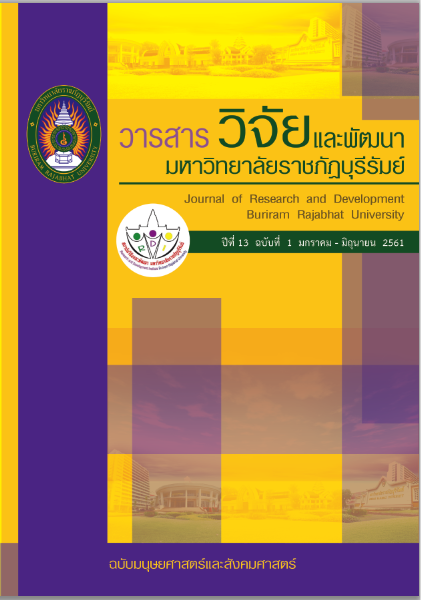การพัฒนารูปแบบนวัตกรรมและกลยุทธ์ทางการตลาดที่มีต่อความภักดีของลูกค้าร้านนมสด
Main Article Content
บทคัดย่อ
การวิจัยครั้งนี้มีวัตถุประสงค์เพื่อ 1) ศึกษาสภาพปัจจุบันของนวัตกรรมผลิตภัณฑ์ กลยุทธ์การตลาด ความพึงพอใจ ความไว้วางใจ และความภักดีของลูกค้าในธุรกิจร้านนมสด 2) ศึกษาอิทธิพลเชิงสาเหตุของนวัตกรรมผลิตภัณฑ์ กลยุทธ์การตลาด ความพึงพอใจ และความไว้วางใจของลูกค้าที่มีต่อความภักดีในธุรกิจร้านนมสดการศึกษาครั้งนี้ผู้วิจัยใช้กระบวนการวิจัยเชิงผสานวิธี (Mixed- Method Research) คือใช้กระบวนการวิจัยเชิงคุณภาพร่วมกับวิจัยเชิงปริมาณ และข้อมูลเชิงลึกจากการสัมภาษณ์ กลุ่มตัวอย่างที่ใช้ในการวิจัยคือลูกค้าของร้านนมสดในเขตกรุงเทพมหานครจำนวน 392 ตัวอย่าง โดยการสุ่มตัวอย่างและใช้แบบสอบถามเป็นเครื่องมือในการเก็บรวบรวมข้อมูล นอกจากนี้ยังใช้การสัมภาษณ์แบบเจาะลึกจากผู้เชี่ยวชาญทางด้านการตลาด 15 ท่าน ผลการวิจัยเชิงปริมาณพบว่า 1) นวัตกรรมผลิตภัณฑ์ กลยุทธ์ทางการตลาด ความพึงพอใจของลูกค้า ความไว้วางใจของลูกค้า และความภักดีของลูกค้าอยู่ในระดับปานกลาง 2) นวัตกรรมผลิตภัณฑ์ กลยุทธ์ทางการตลาด ความพึงพอใจและความไว้วางใจมีอิทธิพลต่อความภักดีของลูกค้า นอกจากนี้จากการวิจัยเชิงคุณภาพ พบว่า ความภักดีของลูกค้าเกิดจากความชื่นชอบในอัตลักษณ์ของผลิตภัณฑ์แบบดั้งเดิม ซึ่งสามารถสร้างความนิยมได้มากกว่าตัวผลิตภัณฑ์ที่เป็นนวัตกรรมใหม่ ๆ ผลการวิจัยครั้งนี้สามารถนำไปใช้เป็นแนวทางในการวางแผนและดำเนินธุรกิจร้านนมสด โดยเน้นอัตลักษณ์ดั้งเดิมของผลิตภัณฑ์เพื่อสร้างความพึงพอใจ และความไว้วางใจของลูกค้า ซึ่งทำให้เกิดความภักดีของผลิตภัณฑ์อย่างยั่งยืน
Article Details
เนื่อหาและข้อมูลในบทความ เป็นความรับผิดชอบของผุ้แต่ง
บทความในวารสารเป็นลิขสิทธิ์ของวารสารวิจัยและนวัตกรรมท้องถิ่น
เอกสารอ้างอิง
2. ญาใจ รีนับถือ. (2554). แผนธุรกิจ ร้านปุงปังมนสด.
3. วิสิษฐ์ จงจิตเจริญพร. (2545). "มนต์นมสด" ตำนานความอร่อยของร้านขนมปัง-นมสด.
4. ศิริวรรณ เสรีรัตน์, ศุภร เสรีรัตน์, ปณิศา มีจินดา และอรทัย เลิศวรรณวิทย์. (2550). กลยุทธ์ การตลาดและการบริหารเชิงกลยุทธ์โดยมุ่งที่ตลาด. กรุงเทพฯ: ธนธัชการพิมพ์.
5. Anderson, J. (2011). The gravity model. Annual Review of Economics, 3, 133-160.
6. Arranz, N. and de Arroyabe J. C. F. (2012). Can innovation network projects result in efficient performance? Technological Forecasting & Social Change.
7. Backström, T., Wilhelmson, L., Åteg, M., Olson, B. K. and Moström Åberg, M. (2011). The Role of Manager in the Post-Industrial Work System. In Studies in industrial renewal.
8. Baum, J. R., Bird, B. J., & Singh, S. (2011). The practical intelligence of entrepreneurs: Antecedents and a link with new venture growth. Personnel Psychology.
9. Bessant, J., von Stamm, B. M., Moeslein, K. M. and Neywer, A.-K. (2010). Backing outsiders: selection strategies for discontinuous innovation. R&D Management.
10. Choi, C. &Sheel, A. (2012). Assessing the Relationship Between Waiting Services and Customer Satisfaction in Family Restaurants. Journal of Quality Assurance in Hospitality & Tourism, 13, 24-36.
11. Haumann, T., Quaiser, B., Wieseke, J., & Rese, M. (2014). Footprints in the Sands of Time: A Comparative Analysis of the Effectiveness of Customer Satisfaction and CustomerCompany Identification over Time. Journal Of Marketing, 78(6), 78-102. doi:10.1509/jm.13.0509
12. Heidi Olander et al .(2013). HR‐related Knowledge Protection and Innovation Performance: The Moderating Effect of Trust.
13. Isaksen, S., G. and Ekvall, G. (2010). Managing for Innovation: The Two Faces of Tension in Creative Climates. Creativity and innovation management, 19(2), 73-88.
14. Ivus, O. (2010). Do stronger patent rights raise high-tech exports to the developing world?. Journal of International Economics.
15. Johannessen, J.-A. and Olsen, B. (2011). Projects as communicating systems: Creating a culture of innovation and Performance. International Journal of Information Management, 31, 30–37.
16. Johnsson, M. (2011).Untapped Innovation Capacity within Ordinary Employees Work-activities. Paper presented at the 4th ISPIM Innovation Symposium in Wellington, New Zeeland.
17. Kotler P, Keller KL (2011). Marketing Management.14th edn. Upper Saddle River: Pearson/Prentice Hall.
18. Kotelinikov V, (2008). Corporate Vision,Mission,Goal and Strategies:Traditional and New Apporoaches to Corporate Vision and Strategic Intent Formulation and Use. Ten3 BUSINESS e-COACH.
19. Mohammad Haghighi , Ali Dorosti , Afshin Rahnama and Ali Hoseinpour. (2012). Evaluation of factors affecting customer loyalty in the restaurant industry Faculty of Management, University of Tehran, Tehran, Iran. 2Department of Business Management, Parsabed Branch, Islamic Azad Univeristy, Parsabed, Iran.
20. Oliver R.L. (1997). Satisfaction: A Behavioral Perspective on the Consumer. Boston: McGraw-Hill.
21. Olivero, M. P. and Y. V. Yotov.(2012) “Dynamic gravity: endogenous country size and asset accumulation.” Canadian Journal of Economics.
22. Simay Attila Endre. ( 2011). A lojalitás és a váltási költségek a mobiltelefonos szolgáltatási szektorban, eloadás, 12. Gazdaságpszichológiai Kutatási Fórum, Szeged, 2011. május 6. In Hámori Balázs - Vajda Beáta - Tóth László - Derecskei Anita- Prónay Szabolcs: Érzelmek és indulatok a gazdaságban, ISBN 978-963-306-117-6,477-487.
23. Sahin, A., Zehir, C., & Kitapçi, H. (2011). The Effects Of Brand Experiences, Trust And Satisfaction On Building Brand Loyalty; An Empricial Research On Global Brands , The 7th International Strategic Management Conference, Paris-France.


